Vapor intrusion (VI) results from volatile chemicals migrating to indoor air from sources located below or adjacent to buildings. These sources may be naturally occurring, as in the case of radon gas, or they may be the result of a release of hazardous materials to soil or groundwater. In either instance, indoor air quality can be compromised resulting in increased health risks to the occupants. Two common chemicals associated with VI are the chlorinated solvents perchloroethylene (PCE) and trichloroethylene (TCE).
Health risks posed by VI are the focus of increasing concern by regulatory agencies. Recently EPA released draft guidance documents for the assessment and mitigation of vapor intrusion, and MADEP updated their existing vapor intrusion guidance document to reflect new toxicological information.
This new information has required regulatory agencies to respond quickly to implement changes in guidance and policy. For example, an EPA study identified an increased risk of birth defects associated with short-term exposure to TCE by pregnant women. Based on this new information, MADEP implemented new exposure limits for TCE in indoor air and is currently revising groundwater standards to reflect this increased risk.
The risk posed by VI, and its elimination, is the main priority for contaminated sites. Where traditional technologies to address contaminant releases (excavation or in-situ remediation) are expensive and require time to implement, technologies designed to eliminate VI exposures have become the remedial option of choice among regulators.
One highly effective technology is sub-slab depressurization (SSD). SSD systems are now the technology of choice to address VI because they are effective in reducing up to 99.9% of volatile contamination in indoor air. SSD systems can be installed into pre-existing buildings (a $2,000 system is usually sufficient for a residence), operational costs are low, and the fan motors will last up to 15 years before needing replacement. These systems are very similar to systems for treating radon gas and can be installed unobtrusively within the occupied spaces. A "U-tube" manometer display indicates the system is operating. The fans are mounted on the exterior of the building where the decreased noise levels go unnoticed.
These systems are flexible enough to accommodate building variations from single point systems employing one fan motor, to larger commercial systems employing a dozen extraction points with four fan motors. At former dry cleaner sites, Norfolk has utilized SSD systems to reduce PCE in indoor air to below laboratory detection limits. A range of costs of $1,800 to $8,000 is typical. Where residual contamination remains problematic for continuing VI, these systems will be operated for many years, with reasonable electrical costs, and with minimal required maintenance.
The use of SSD can be an important consideration for the real estate developer that wants to develop land formerly contaminated with volatile organics by providing a highly effective, cost-efficient approach to addressing VI problems. By freeing up resources to address this condition, SSD systems allow developers and environmental professions to continue to work towards long-term solutions to these problems.
Charles Young is an associate with the Norfolk Ram Group, LLC, Milford, Mass.
Tags:
Sub-slab depressurization is a highly effective technology to eliminate vapor intrusion
November 14, 2013 - Construction Design & Engineering
 (1).jpg)








.png)